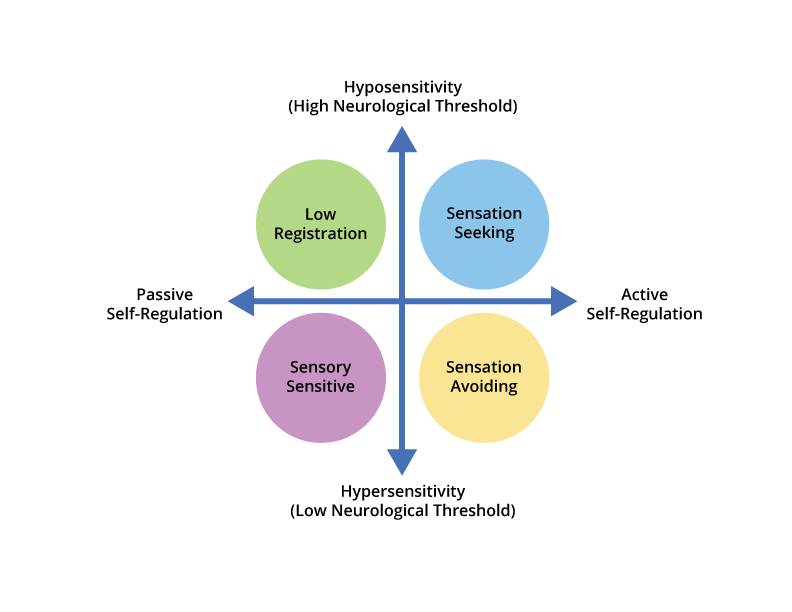All children are unique and it is likely you will encounter children with different sensory processing challenges at the same time.
There are tip sheets on each of the seven senses: smell, taste, touch, vision, hearing, vestibular, and proprioceptive. Each sheet provides detailed information for programming on those individual senses. When developing any programming for a child, it is common to identify if the child is sensitive to stimuli within a particular sense. Below is a chart to help you understand an individual child’s needs.

There are the four patterns of sensory processing: low registration, sensation seeking, sensory sensitive and sensation avoiding.
Low registration: A child with low registration does not recognize or process all of the incoming sensory information, and they do not compensate by trying to gain more sensory input to meet their needs. They may seem uninterested, and inattentive to their surroundings.
Sensation seeking: A child classified as sensation seeking does not recognize or process all of the incoming sensory information, but contrary to low registration, they actively try to gain this sensory input to meet their needs. They may be hyperactive, touch others often or engage in unsafe activities like jumping from heights.
Sensory sensitive: A child classified as sensory sensitive feels overwhelmed by sensory information, but they do not actively try to avoid the overstimulation, instead they may just display frustration. They may be easily distracted, and irritable, cautious, and uncomfortable in loud or bright environments.
Sensation avoiding: A child that is sensation avoiding feels overwhelmed by sensory information and will actively avoid the stimulation. They may run away from loud, busy environments, cover their ears when overstimulated by noise, or wear gloves to avoid touching certain materials such as paint.
Here are some general strategies you can use to manage a large number of children with different sensory processing challenges:
- Whenever possible try to minimize the sensory stimuli in a room. For example, avoid fluorescent lighting and loud noises. Although some children may require extra input, it is easier to give them this input individually in alternate ways that do not involve disturbing the hypersensitive individuals in the room. For e.g., for children that require additional visual input, provide visually stimulating items such as a lava lamp. For children who require extra auditory input, provide sound-producing toys, such as a shaker.
- Have a designated area in the classroom that children can go to and calm their nervous system if they become overwhelmed. This strategy is useful with most children that are hypersensitive to any of the seven senses.
- Give children options. Provide children materials such as a fidget spinner or exercise ball to use if they are seeking this type of input.
- Communicate with the child’s caregivers to learn about the child’s likes and dislikes and strategies that work at home that can be easily transferred to the classroom environment.
Reference:
Dunn, Winnie (2007), Dunn’s Four Quadrant Model of Sensory Processing.
